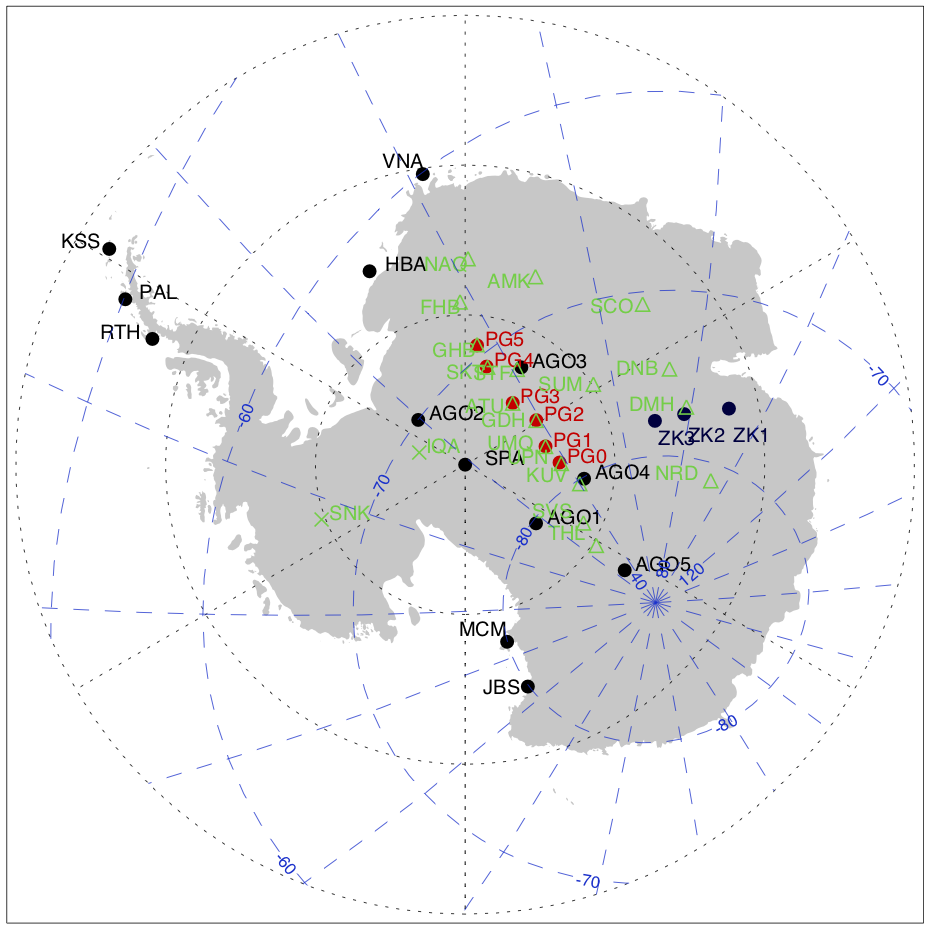
Antarctic 40 Degree Magnetic Meridian Chain
Virginia Tech sites are shown in red.
Magnetic conjugate locations in Greenland are marked in green.
Other magnetometer stations are marked in black.
About the AAL-PIP Magnetometer Instruments
A digital, low-powered magnetometer system was tested at South Pole in 2006-2007 and moved onto the Antarctic Plateau in January 2008 to location 'PG1', at lat=-85.50 lon=77.20. Another magnetometer was placed at 'PG2', lat= -84.42 lon= 57.96, in January 2009 and removed in December 2010 for repairs. Magnetometers having more advanced designs, including the addition of search coils, were installed at South Pole Station (lat =-89.98) in December, 2010 and 2011 for testing until final placement. 'System 3' was moved to location PG2 in January 2012, and replaced with 'System 4' in December 2012. 'System 5' was set up at location PG3 in January 2013. Three other magnetometers were moved to the Antarctic Plateau in 2014 to January 2016, at locations PG0, PG4, and PG5. These magnetometers complete the PENGUIn (Polar Experimental Network for Geospace Upper atmosphere Investigations) 40 degree magnetic meridian chain, conjugate to a chain on the western Greenland coast.
The systems are designed for 5-year operation, unattended. 1-second vector geomagnetic variations are transmitted from the station via Iridium satellite communications links. To save power during the dark winter, the vector magnetic data are stored and only station housekeeping data are transmitted. The stored winter data are retrieved during the summer when power is available from the solar panels. The graphs above show the most recent data that have been obtained.
Magnetosphere Ionosphere Science Team (MIST)
The Magnetophere - Ionosphere Science Team (MIST) is a part of Space Physics Research Group at Virginia Tech. Several people in this team are located at the National Institute of Aerospace, in Hampton, Virginia. We primarily investigate the interaction between the Earth's "magnetosphere" and its ionosphere. The magnetosphere is the cavity formed by the interaction between the solar wind and Earth's main magnetic field, that is generated by electric currents deep within the planet's core. The ionosphere is the top-most layer of the atmosphere, extending into space, where the atoms have been ionized by the ultraviolet rays from the Sun, forming a conductive "plasma". The magnetosphere is also filled with plasma. The regions of the magnetosphere that have magnetic field line "footprints " in either of two, oval-shaped regions in the ionosphere surrounding the polar caps collectively account for the aurora. Large-scale current systems and other effects carry momentum and energy from high to lower altitudes, resulting in electric fields and currents in the ionosphere. The driving force of this energy flow is the solar wind and the "Interplanetary Magnetic Field," known as the "IMF," which is carried outward from the Sun by the solar wind. The electric currents in the ionosphere produce variations in the magnetic field at the surface of the Earth. Measurements of these variations with magnetometers are often used to study the Magnetosphere-Ionosphere system.
Space @ Virginia Tech
The Center for Space Science and Engineering (Space@VT) comprises a group of faculty, students and staff devoted to the investigation of the space environment. We presently include members from the Bradley Department of Electrical and Computer Engineering and the Department of Aerospace and Ocean Engineering and the Center resides in the College of Engineering. Our mission is to provide forefront research, instruction, and educational outreach in the fields of space science and engineering utilizing a holistic approach of theoretical modeling, advanced simulation techniques, space system and instrument design, and experimental data acquisition, analysis and interpretation. To learn more, we invite you to explore the other links within the Space@VT web site. If you have comments or require additional information, please feel free to contact the center Director, Prof Scott Bailey (baileys@vt.edu ) or our center administrator Ms. Debra Collins (collinsd@vt.edu ).
